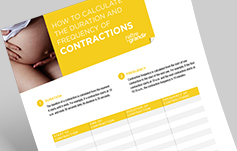Causes and signs of preterm delivery and strategies to delay it.
Pregnancy usually lasts 37 to 42 weeks. Premature or preterm labour occurs when a baby is born too early, between 20 and 37 weeks.
Babies who are born prematurely are more likely to have health problems and may be very ill. When a baby is born before 37 weeks of pregnancy, their body is formed, but their organs are not fully mature, especially their lungs. Premature babies need specialized care and often have to stay in hospital for several weeks or even months.
What increases the risk of preterm labour?
Preterm delivery is one of the most common complications of pregnancy. In about half of cases, the cause remains unknown.
However, certain factors are known to increase the risk of going into labour too early:
-
A previous miscarriage or preterm delivery
- Unhealthy lifestyle (smoking, drug or alcohol use, stress, poor diet)
- Difficult working conditions (long hours, standing for extended periods, extreme temperatures, intense effort)
- Age (under 18 or over 35)
- Physical or psychological violence
- Certain conditions affecting the uterus that cause the cervix to dilate prematurely or prevent it from remaining closed
-
Dental, urinary, vaginal, or uterine infections
- Low maternal weight before pregnancy or insufficient weight gain during pregnancy
-
A condition where the placenta attaches to and develops on the cervix (placenta previa)
-
A multiple pregnancy
- Premature rupture of membranes or leaking amniotic fluid before the baby is full-term
-
Maternal health problems (high blood pressure, diabetes)
- Fetal anomalies
What are the signs of preterm labour?
The following signs may indicate that you are going into labour:
-
Contractions every 10 minutes or less. They can feel like menstrual cramps or a tightening in the abdomen (uterus).
-
Watery fluid discharged from the vagina.
Our downloadable guide will help you calculate the duration and frequency of your contractions.

-
A foul-smelling liquid discharged from the vagina accompanied by itching.
-
An increase in vaginal discharge and changes in its appearance (mucous membranes, fluid, blood).
-
A feeling of pressure on the pelvis or vagina, as if the baby is pushing down.
-
Continuous abdominal pain (with or without diarrhea).
-
Dull and uncomfortable pain (internal pain that is not severe) in the lower back that comes and goes.
-
Urgent or frequent need to urinate.
How can preterm labour be stopped?
If you experience any of the previously mentioned signs of preterm labour, call your hospital’s maternity ward or midwife. The health care staff will be able to guide you and determine if an on-site assessment is necessary.
Some interventions can be attempted to delay or stop preterm labour and reduce the risk of a premature birth.
- Cervical cerclage: This involves the temporary surgical closure of the cervix. To determine if this procedure is necessary, the medical team will perform several ultrasound scans to assess cervical length.
- Treatment with antibiotics: If urine, cervical, or vaginal samples reveal an infection, you will be treated with antibiotics.
- Medication: Certain drugs can be administered to slow or stop labour contractions.
If these procedures work, your doctor may advise you to reduce your hours of work and avoid travel. They might also suggest that you limit your sexual activity. Stimulating the nipples or genital area can cause the release of oxytocin, a hormone that triggers contractions. In addition, the prostaglandins in semen can cause cervical ripening and, in turn, promote preterm labour.
If labour can’t be stopped, steroids can be administered to speed up the development of the baby’s lungs.
What can you do to reduce the risk of preterm labour?
Even though it’s impossible to prevent all premature births, there are still some things you can do to reduce the risk of preterm labour:
-
Start your prenatal checkups as soon as possible.
-
Attend prenatal classes early on in your pregnancy.
-
Try to quit smoking or smoke less. Ask people around you not to smoke when they’re near you.
-
Eat healthy food and ensure adequate weight gain.
-
Take time to rest every day.
-
Find ways to cope with stress. Talk to your prenatal care provider.
-
See your health care provider right away if you experience pain while urinating or if you have foul-smelling vaginal discharge accompanied by itching.
-
Get any dental or urinary infections treated.
-
Learn to recognize the signs of preterm labour, and know what steps to take if you experience them. Make sure your partner knows them as well.
-
Be aware of any changes in your body during pregnancy. Talk to your health care provider if anything doesn’t feel right.
Things to keep in mind
-
It’s important to know the signs of preterm labour.
-
If it seems like you’re going into labour, you should go to the birthing centre or hospital as soon as possible.
-
Opting for a healthy lifestyle reduces the chances of going into preterm labour.
| Scientific review: Roxanne Piché, nursing adviser, Maternal Fetal Medicine Clinic, CHU Sainte-Justine
Research and copywriting:The Naître et grandir team
Updated: March 2020
|
Sources
Please note: Hyperlinks to other websites are not updated regularly, and some may have changed since publication. If a link is no longer valid, use search engines to find the information you’re looking for.
-
Lim, Kenneth, et al. “Ultrasonographic cervical length assessment in predicting preterm birth in singleton pregnancies,” Journal of Obstetrics and Gynaecology Canada, vol. 40, no. 2, 2018, pp. e165–e180.
-
Lowdermilk, Perry, et al. Périnatalité. 2nd ed., Chenelière Éducation, 2019, pp. 1,018.
-
Best Start. “Preterm labour.” www.educationprenatalontario.ca
-
The Society of Obstetricians and Gynaecologists of Canada. “Preterm labour.” www.pregnancyinfo.ca
|